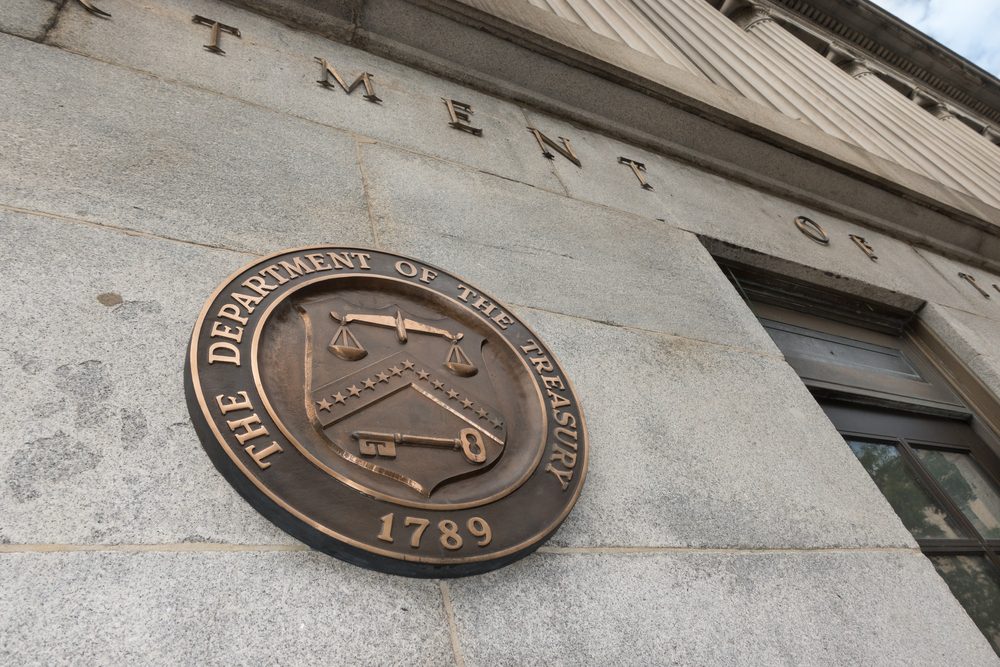Finance
Treasury Department to Use ‘Automation and Innovation’ to Fight Illicit Finance

The Department of the Treasury has outlined the priorities it will pursue this year to step up the fight against illicit finance.
The agency aims to increase transparency, leverage partnerships and support responsible technological innovation, it said in a Thursday (May 16) press release announcing the publication of its “2024 National Strategy for Combating Terrorist and Other Illicit Financing.”
One of the Department’s priorities for the year is closing legal and regulatory gaps in the country’s anti-money laundering and combating the financing of terrorism (AML/CFT) framework, according to the release. It aims to do so by operationalizing the beneficial ownership information registry; finalizing rules covering the residential real estate and investment advisor sectors; and assessing the vulnerability of other sectors.
A second priority is promoting a more effective and risk-focused AML/CFT regulatory and supervisory framework for financial institutions, the release said. The Department will work to do so by providing clear compliance guidance, sharing information and providing resources for supervision and enforcement.
The Department also aims to enhance the operational effectiveness of law enforcement, other U.S. government agencies and international partnerships to combat illicit finance, per the release.
The fourth priority announced in the press release is realizing “the benefits of responsible technological innovation” by developing new payments technology, supporting the use of new mechanisms for compliance, and using automation and innovation to find new ways to fight illicit finance, the release said.
“In this critical moment for our national and economic security, we need to continue to close the pathways that illicit actors seek to exploit for their schemes,” Brian E. Nelson, Under Secretary of the Treasury for terrorism and financial intelligence, said in the release. “We recognize the threat illicit financial activity represents to our national security, economic prosperity, and our democratic values, and are focused on addressing both the challenges of today and emerging concerns.”
These recommendations are meant to address key risks the Department of the Treasury identified in February in its “2024 National Money Laundering, Terrorist Financing, and Proliferation Financing Risk Assessments.”
In another recent move, the Treasury Department said in April that it wants more tools to curb terror financing.
In testimony released ahead of an April 9 appearance before the Senate Banking Committee, Deputy Secretary Wally Adeyemo said terrorist groups and state actors continually “seek new ways to move their resources in light of the actions we are taking to cut them off from accessing the traditional financial system.”
For all PYMNTS B2B coverage, subscribe to the daily B2B Newsletter.

Finance
Barksdale Announces Closing of Private Placement Financing

Vancouver, British Columbia–(Newsfile Corp. – July 26, 2024) – Barksdale Resources Corp. (TSXV: BRO) (“Barksdale” or the “Company“) is pleased to announce the closing of the second and final tranche (“Final Tranche“) of its previously announced non-brokered private placement offering (“Offering“) of units of the Company (“Units“) with the issuance of 14,674,683 Units for gross proceeds of $2,201,202.45. The first tranche (“First Tranche“) of the non-brokered private placement offering comprising 27,325,317 Units for gross proceeds of $4,098,798 closed on June 27, 2024 (see news release dated June 27, 2024). The Units sold in respect of the First Tranche and Final Tranche, together, total 42,000,000 for gross proceeds of $6,300,000.
Each Unit consists of one common share of Barksdale (a “Common Share“) and one Common Share purchase warrant (a “Warrant“), whereby each Warrant entitles the holder to acquire one Common Share at a price of $0.23 for a period of three years from the date of issuance.
Proceeds of the Offering will be used to finance exploration activities at the Company’s properties in Arizona as well as for working capital and general corporate purposes. Pursuant to the closing of the Offering, the Company paid an aggregate of (i) $199,516.60 in cash finder’s fees and issued an aggregate of 1,330,111 finder’s warrants to eligible finders in connection with the First Tranche, and (ii) $64,396.49 in cash finder’s fees and issued an aggregate of 429,309 finder’s warrants to eligible finders in connection with the Final Tranche. The finder’s fees in respect of the Offering, therefore, total $263,913.09 and 1,759,420 finder’s warrants. Each finder’s warrant entitles the holder to acquire one Common Share at a price of $0.23 until June 27, 2027 (First Tranche) or July 27, 2027 (Final Tranche).
All securities issued pursuant to the (i) First Tranche are subject to a statutory hold period expiring October 28, 2027, and (ii) Final Tranche are subject to a statutory hold period expiring November 27, 2027; each expiration date being the date that is four months and one day from the date of issuance. The Offering remains subject to TSX Venture Exchange final acceptance.
The securities described herein have not been, and will not be, registered under the United States Securities Act of 1933, as amended (the “U.S. Securities Act“), or any state securities laws, and may not be offered or sold within the United States except in compliance with the registration requirements of the U.S. Securities Act and applicable state securities laws or pursuant to available exemptions therefrom. This release does not constitute an offer to sell or a solicitation of an offer to buy of any securities in the United States.
Related Party Participation in the Offering
Certain insiders of the Company participated in the Offering. For details of insider participation in the First Tranche, please see news release dated June 27, 2024. In connection with the Final Tranche, Crescat Portfolio Management LLC, an insider of the Company as it has ownership of, or control or direction over, directly or indirectly, securities of Barksdale carrying more than 10% of the voting rights attached to all the Company’s outstanding voting securities, purchased 6,666,667 Units. In addition, Rick Trotman, Chief Executive Officer and Director of Barksdale, purchased 118,317 Units. The participation by insiders in the Offering constitutes a “related party transaction” as defined under Multilateral Instrument 61-101 – Protection of Minority Security Holders in Special Transactions (“MI 61-101“). The Company is relying on the exemptions from the valuation and minority shareholder approval requirements of MI 61-101 contained in sections 5.5(a) and 5.7(1)(a) of MI 61-101, as neither the fair market value of the securities purchased by insiders, nor the consideration for the securities paid by such insiders, will exceed 25% of the Company’s market capitalization. The Company did not file a material change report in respect of the related party transaction at least 21 days before the closing of either the First Tranche or the Final Tranche, which the Company deems reasonable in the circumstances in order to complete the Offering in an expeditious manner. The Offering was unanimously approved by the Company’s board of directors.
Barksdale Resources Corp., a 2023 OTCQX BEST 50 Company, is a base metal exploration company headquartered in Vancouver, B.C., that is focused on the acquisition, exploration and advancement of highly prospective base metal projects in North America. Barksdale is currently advancing the Sunnyside copper-zinc-lead-silver project in the Patagonia mining district of southern Arizona, which hosts several significant porphyry copper deposits as well as the adjoining world-class Hermosa carbonate-replacement lead-zinc-silver deposit which is under construction by a major mining company.
ON BEHALF OF BARKSDALE RESOURCES CORP
Rick Trotman
President, CEO and Director
Rick@barksdaleresources.com
Terri Anne Welyki
Vice President of Communications
778-238-2333
TerriAnne@barksdaleresources.com
For more information please phone 778-558-7145, email info@barksdaleresources.com or visit www.BarksdaleResources.com.
Neither TSX Venture Exchange nor its Regulation Services Provider (as that term is defined in the policies of the TSX Venture Exchange) accepts responsibility for the adequacy or accuracy of this release.
CAUTIONARY STATEMENT REGARDING FORWARD-LOOKING INFORMATION: This news release contains certain “forward-looking information” and “forward-looking statements” (collectively “forward-looking statements”) within the meaning of applicable securities legislation. Forward-looking statements are frequently, but not always, identified by words such as “expects”, “anticipates”, “believes”, “intends”, “estimates”, “potential”, “possible”, and similar expressions, or statements that events, conditions, or results “will”, “may”, “could”, or” should” occur or be achieved. All statements, other than statements of historical fact, included herein, without limitation, statements relating to TSX Venture Exchange approval and the use of proceeds from the Offering are forward-looking statements. There can be no assurance that such statements will prove to be accurate, and actual results and future events could differ materially from those anticipated in such statements. Forward-looking statements reflect the beliefs, opinions and projections on the date the statements are made and are based upon a number of assumptions and estimates that, while considered reasonable by Barksdale, are inherently subject to significant business, economic, competitive, political and social uncertainties and contingencies. Many factors, both known and unknown, could cause actual results, performance or achievements to be materially different from the results, performance or achievements that are or may be expressed or implied by such forward-looking statements and the Company has made assumptions and estimates based on or related to many of these factors. Such factors include, without limitation, the ability to obtain necessary approvals, the ability to complete proposed exploration work, the results of exploration, continued availability of capital, and changes in general economic, market and business conditions. Readers should not place undue reliance on the forward-looking statements and information contained in this news release concerning these items. Barksdale does not assume any obligation to update the forward-looking statements of beliefs, opinions, projections, or other factors, should they change, except as required by applicable securities laws.
// NOT FOR DISTRIBUTION TO UNITED STATES NEWSWIRE SERVICES OR FOR DISSEMINATION IN THE UNITED STATES //
To view the source version of this press release, please visit https://www.newsfilecorp.com/release/218027
Finance
I’m a Financial Advisor: 6 Year-End Tax Moves My Wealthy Clients Make

The dog days of summer might seem like a strange time to start thinking about the right year-end tax moves. After all, you still have to go through spooky season and the holidays well before the taxman comes a callin’. Yet planning your tax moves well in advance can help you preserve more of your wealth long before you have to sign those forms.
Find Out: Should Trump Eliminate Income Taxes? Here’s What Tax Experts Say
For You: 7 Reasons You Should Consider a Financial Advisor — Even If You’re Not Wealthy
As the founder and CEO of 11 Financial, Taylor Kovar, CFP, has experience in helping wealthier clients make those savvy tax moves. GOBankingRates connected with Kovar to get his insights about what people with higher incomes can do to get their taxes in order as the end of the year approaches (it’ll be here sooner than you know).
Contribute to Tax-Advantaged Retirement Accounts
One of Kovar’s first big pieces of advice for wealthy clients is to ensure that they’re maximizing contribution to tax-advantaged retirement accounts, like 401(k)s, IRAs and Roth IRAs.
“For 2024, the contribution limits are $22,500 for 401(k)s ($30,000 if over age 50) and $6,500 for IRAs ($7,500 if over age 50),” he said. “Making these contributions can reduce taxable income and boost long-term savings.”
Read Next: This Is the One Type of Debt That ‘Terrifies’ Dave Ramsey
Focus on Charitable Giving
Giving money to causes that inspire you doesn’t just do your heart and soul some good, it can also have great benefits for your bottom line. Kovar recommends that his clients consider making donations to qualified charities before the year’s end to help save on taxes.
“Additionally, they can donate appreciated assets such as stocks or real estate to avoid capital gains taxes and receive a charitable deduction,” he added. “For those 70 and a half and older, qualified charitable distributions from IRAs can be a tax-efficient way to give.”
Explore Tax-Loss Harvesting
While the word harvesting conjures images of plucking fresh fruits and vegetables out of the ground, tax-loss harvesting can help you generate more green. As Kovar explained it, tax-loss harvesting involves selling investments at a loss to offset capital gains and reduce taxable income.
“Investors should review their portfolios to identify underperforming assets that can be sold to realize losses and minimize their tax liability,” he said.
Make Annual Gifts
Kovar also recommends that his wealthy clients make annual gifts to reduce their estate size and potentially avoid estate taxes. Even better? They get to see the recipient enjoy their gift. For 2024, the annual gift tax exclusion is $17,000 per recipient.
“Reviewing and updating estate planning documents and strategies can ensure that their estate plan is aligned with current laws and personal goals,” he added.
Convert to a Roth IRA
If you’re expecting your income to increase in the future, you might consider converting traditional IRAs or other tax-deferred accounts to Roth IRAs.
Kovar shared that Roth conversions can be taxed in the year of conversion. However, they provide tax-free growth and withdrawals in retirement.
Take RMDs
New Year’s Eve should be more than your last chance to party before the end of the year, it’s also the last day of the year you can take required minimum distributions (RMDs) to avoid penalties.
“Investors who turn 72 this year need to start taking RMDs, and those already taking them should verify they have met the requirements,” said Kovar.
More From GOBankingRates
This article originally appeared on GOBankingRates.com: I’m a Financial Advisor: 6 Year-End Tax Moves My Wealthy Clients Make
Finance
2 charts show why the stock market sell-off isn't done yet
The roaring stock market rally of 2024 has finally hit a pause.
The S&P 500 (^GSPC) and Nasdaq Composite (^IXIC) tallied their worst one-day drops since 2022 on Wednesday and extended those losses on Thursday. Over the past 10 days the benchmark S&P 500 is down about 3%, while the Nasdaq is down more than 6%.
The recent pause in the rally’s chug higher aligns with calls from equity strategists in our recently released third volume of the Yahoo Finance Chartbook. Truist co-chief investment officer Keith Lerner noted that in years when the S&P 500 has risen more than 10% in the first half of the year, the second half usually sees an average pullback of about 9%.
Through the end of June, the S&P 500 was up about 14%.
“This choppier market action of late, which we have been anticipating, likely has further to go in terms of price and time,” Lerner wrote in a note to clients on Thursday.
Tech has been the clear leader of the recent market drawdown. Information Technology and Communication Services are the only two of the 11 sectors in the S&P 500 with negative returns over the past month. In an interview with Yahoo Finance, Lerner reasoned that the recent sell-off in Tech made sense given how far up the sector had run.
In late June, tech had outperformed the S&P 500 on a rolling two-month basis by the most since 2002, per Lerner’s research. Lerner reasons that, like a rubber band that becomes overstretched, there’s usually a snapback from extreme levels of outperformance in markets.
“When we get that stretched, a little bit of bad news can go a long way,” Lerner said.
The “little bit of news” came via earnings reports from Alphabet (GOOGL, GOOG) and Tesla (TSLA) after the bell on Tuesday leading into Wednesday’s sell-off. Lerner noted that the earnings weren’t bad but failed to impress investors, who had a high bar entering this reporting season.
Earnings from Apple (AAPL), Meta (META), Microsoft (MSFT), and Amazon (AMZN) expected next week will prove the next test for investor sentiment in the tech sector. Lerner reasoned that, after the market reset over the past few trading sessions, there’s a chance technology’s latest swath of earnings can surpass investors’ now-trimmed expectations.
“I think the secular story of this bull market is still intact,” Lerner said. “Money will come back there. I just think more likely you need a resting period and kind of a pause that refreshes.”
BMO Capital Markets chief investment strategist Brian Belski also highlighted the likelihood of a pause in stocks’ climb higher in the latest edition of our Chartbook. Similarly to Lerner’s analysis, Belski’s work shows that going back to 1949, the second year of a bull market sees a roughly 9% average pullback. The most recent bull market started in October 2022.
Belski told Yahoo Finance on Tuesday that the market was “ripe for a pullback from a sentiment perspective.” But to Belski, this is a “buying opportunity.” His research shows that markets typically bounce back an average of 14.5% from the bottom of the second-year bull market drawdowns he studied.
“Stocks will be higher at year-end,” Belski said.
Josh Schafer is a reporter for Yahoo Finance. Follow him on X @_joshschafer.
Click here for in-depth analysis of the latest stock market news and events moving stock prices
Read the latest financial and business news from Yahoo Finance
-

 World1 week ago
World1 week agoOne dead after car crashes into restaurant in Paris
-

 Midwest1 week ago
Midwest1 week agoMichigan rep posts video response to Stephen Colbert's joke about his RNC speech: 'Touché'
-

 News1 week ago
News1 week agoVideo: Young Republicans on Why Their Party Isn’t Reaching Gen Z (And What They Can Do About It)
-

 Movie Reviews1 week ago
Movie Reviews1 week agoMovie Review: A new generation drives into the storm in rousing ‘Twisters’
-

 News1 week ago
News1 week agoIn Milwaukee, Black Voters Struggle to Find a Home With Either Party
-

 Politics1 week ago
Politics1 week agoFox News Politics: The Call is Coming from Inside the House
-

 News1 week ago
News1 week agoVideo: J.D. Vance Accepts Vice-Presidential Nomination
-

 World1 week ago
World1 week agoTrump to take RNC stage for first speech since assassination attempt




















